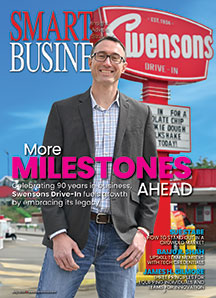Perhaps like many business owners, Jeff Burt’s biggest challenge in the six years since he founded Eclipse Studios has been keeping up with technology.
It’s especially important to Burt, however, considering he started the commercial photography studio with a distinct vision of having a cutting edge reputation.
Indeed, technology is what Burt credits for the Northwest Columbus company’s fast growth, averaging more than 40 percent annually and expecting to surpass the $1 million mark this year. It hasn’t been without cost: Burt has spent as much as 50 percent of his annual budget on technology advances.
“Whenever I buy anything with new technology or new equipment,” he says, “I have to be sure it’s something I can turn a profit on within the first year or two. If not, it’s going to become obsolete.”
That’s a change he’s seen since the mid-’80s.
“Photography used to be, buy cameras and lights and you’re done for 20 years,” he says. “Today, you have to invest and invest and invest.”
So far, he says, he’s been lucky. He’s made some purchases that haven’t turned the profit he expected, but the equipment still was of use so he considers it a break-even investment.
One of his most successful investments, on the other hand, was digital backs — attachments to the camera that allow digital photography instead of film processing.
“The back alone is almost $60,000,” he says.
However, last year he landed a job because of the digital capabilities and took in nearly $30,000 for that project alone.
“When we purchased (the backs), it took us to a completely different level because it enabled us to get the client the same quality of photograph at a quicker rate and saved them a lot of money on developing,” Burt says.
Here’s how he keeps up with the technology that runs his business.
- Start with the homework.
Burt visits many industry trade shows and subscribes to trade magazines.
“Trade shows are the biggest because you can see it working in action,” he says. “As much as we keep purchasing, we take our time with it. We don’t just fly into it real fast.”
He also asks clients what they want and tries to find equipment to fill those needs.
- Know your budget.
“I get my wish list together — all the things I want to have,” he says. “Then I do a reality check.”
He decides what will be the most profitable right away for the company, then decides where he wants his sales-to-expenses ratio to be for the year.
“Some years we make the conscious decision this will be a growth year,” he says. “When we do that, sometimes the profit margin drops a little bit, but hopefully the next year it’s going to come back to us.”
- Look at all the options.
Buying new technology isn’t always the answer.
In addition to a purchase, Burt also considers a continual lease or a lease-to-purchase option for items such as printers.
“I do it with a dollar buyout so it’s basically almost like a loan. I can upgrade a continual lease or I can purchase it for a dollar amount,” he says.
Because digital photography is changing so much from year to year, he does a 10 percent buyout so he can upgrade the lease to get new equipment.
“Instead of spending $60,000 in that year’s budget, you’re only spending so much per month on that equipment,” he says.
On the other hand, he typically purchases computers.
“A lot of computers I won’t lease because, although they are expensive, if I lease I’m going to pay a lot more over the years than what they’re worth,” he says.
- Take a test drive.
Burt also practices the try it before you buy it philosophy — even if someone else is trying it for him.
Before he bought his first large-format plotter — an ink-jet printer that can make prints up to 59 inches wide and any length desired — he started telling clients he could take such photographs for trade shows displays or banners. Then he farmed out the work to another company that has that capability.
“I saw we were getting sales in this even though we were not printing it,” he says. “We would make more profit doing it in-house and saved clients money because we didn’t have to do mark-ups, and they got a better quality because we controlled it.”
- Don’t forget the basics.
Sure, you’ve invested in the cutting edge. But can your employees use it?
“When we buy the stuff, we get training right away as part of the deal,” he says.
Plus, he takes some of his eight employees to trade shows with him.
In the end, though, he has to make sure his employees have the basic skills for the job, not just the technological savvy.
Digital photography, for example, allows a photographer to take certain shortcuts — something he doesn’t want his employees doing.
“You can get people fresh out of school who learned strictly digital. Anybody we hire I want to have the traditional background,” he says. “If they have both, great. If not, we train them on the digital side.”
Overall, Burt advises, look at your industry and how the technology is changing.
“I would say research heavily,” he says. “But at the same time, you can’t be afraid of doing it. Somebody else is going to get the business. When I say research, research quickly.” How to reach: Jeff Burt, Eclipse Studios, 457-2025 or www.eclipse-studio.com
Joan Slattery Wall ([email protected]) is associate editor of SBN Magazine in Columbus.

